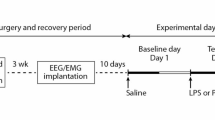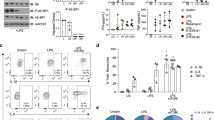Abstract
Inflammation-induced sickness is associated with a large set of behavioral alterations; however, its motivational aspects remain poorly explored in humans. The present study assessed the effect of lipopolysaccharide (LPS) administration at a dose of 2 ng/kg of body weight on motivation in 21 healthy human subjects in a double-blinded, placebo (saline)-controlled, cross-over design. Incentive motivation and reward sensitivity were measured using the Effort Expenditure for Rewards Task (EEfRT), in which motivation for high-effort/high-reward trials vs low-effort/low-reward trials are manipulated by variations in reward magnitude and probability to win. Because of the strong interactions between sleepiness and motivation, the role of sleepiness was also determined. As expected, the probability to win predicted the choice to engage in high-effort/high-reward trials; however, this occurred at a greater extent after LPS than after saline administration. This effect was related to the level of sleepiness. Sleepiness increased motivation to choose the high-effort/high-reward mode of response, but only when the probability to win was the highest. LPS had no effect on reward sensitivity either directly or via sleepiness. These results indicate that systemic inflammation induced by LPS administration causes motivational changes in young healthy subjects, which are associated with sleepiness. Thus, despite its association with energy-saving behaviors, sickness allows increased incentive motivation when the effort is deemed worthwhile.
Similar content being viewed by others
Log in or create a free account to read this content
Gain free access to this article, as well as selected content from this journal and more on nature.com
or
References
Akerstedt T, Anund A, Axelsson J, Kecklund G (2014). Subjective sleepiness is a sensitive indicator of insufficient sleep and impaired waking function. J Sleep Res 23: 240–252.
Andreasson A, Wicksell RK, Lodin K, Karshikoff B, Axelsson J, Lekander M (2016). A global measure of sickness behavior: development of the sickness questionnaire (SicknessQ). Journal of Health Psychology (doi:10.1177/1359105316659917).
Anisman H, Kokkinidis L, Borowski T, Merali Z (1998). Differential effects of interleukin (IL)-1beta, IL-2 and IL-6 on responding for rewarding lateral hypothalamic stimulation. Brain Res 779: 177–187.
Aubert A (1999). Sickness and behaviour in animals: a motivational perspective. Neurosci Biobehav Rev 23: 1029–1036.
Aubert A, Dantzer R (2005). The taste of sickness: lipopolysaccharide-induced finickiness in rats. Physiol Behav 84: 437–444.
Aubert A, Goodall G, Dantzer R, Gheusi G (1997). Differential effects of lipopolysaccharide on pup retrieving and nest building in lactating mice. Brain Behav Immun 11: 107–118.
Berridge KC, Robinson TE, Aldridge JW (2009). Dissecting components of reward: 'liking', 'wanting', and learning. Curr Opin Pharmacol 9: 65–73.
Blinderman CD, Homel P, Billings JA, Portenoy RK, Tennstedt SL (2008). Symptom distress and quality of life in patients with advanced congestive heart failure. J Pain Symptom Manage 35: 594–603.
Blinderman CD, Homel P, Billings JA, Tennstedt S, Portenoy RK (2009). Symptom distress and quality of life in patients with advanced chronic obstructive pulmonary disease. J Pain Symptom Manage 38: 115–123.
Boksem MA, Meijman TF, Lorist MM (2006). Mental fatigue, motivation and action monitoring. Biol Psychol 72: 123–132.
Boksem MA, Tops M (2008). Mental fatigue: costs and benefits. Brain Res Rev 59: 125–139.
Calvano SE, Coyle SM (2012). Experimental human endotoxemia: a model of the systemic inflammatory response syndrome? Surg Infect (Larchmt) 13: 293–299.
Capuron L, Pagnoni G, Drake DF, Woolwine BJ, Spivey JR, Crowe RJ et al (2012). Dopaminergic mechanisms of reduced basal ganglia responses to hedonic reward during interferon alfa administration. Arch Gen Psychiatry 69: 1044–1053.
Dantzer R, Heijnen CJ, Kavelaars A, Laye S, Capuron L (2014). The neuroimmune basis of fatigue. Trends Neurosci 37: 39–46.
Dantzer R, Kelley KW (2007). Twenty years of research on cytokine-induced sickness behavior. Brain Behav Immun 21: 153–160.
Dantzer R, O'Connor JC, Freund GG, Johnson RW, Kelley KW (2008). From inflammation to sickness and depression: when the immune system subjugates the brain. Nat Rev Neurosci 9: 46–56.
De La Garza R 2nd, Asnis GM, Fabrizio KR, Pedrosa E (2005). Acute diclofenac treatment attenuates lipopolysaccharide-induced alterations to basic reward behavior and HPA axis activation in rats. Psychopharmacology 179: 356–365.
Eisenberger NI, Berkman ET, Inagaki TK, Rameson LT, Mashal NM, Irwin MR (2010). Inflammation-induced anhedonia: endotoxin reduces ventral striatum responses to reward. Biol Psychiatry 68: 748–754.
Engler H, Benson S, Wegner A, Spreitzer I, Schedlowski M, Elsenbruch S (2016). Men and women differ in inflammatory and neuroendocrine responses to endotoxin but not in the severity of sickness symptoms. Brain Behav Immun 52: 18–26.
Felger JC, Miller AH (2012). Cytokine effects on the basal ganglia and dopamine function: the subcortical source of inflammatory malaise. Front Neuroendocrinol 33: 315–327.
Hallstrom L, Berghall E, Frostell C, Sollevi A, Soop AL (2011). Immunomodulation by a combination of nitric oxide and glucocorticoids in a human endotoxin model. Acta Anaesthesiol Scand 55: 20–27.
Harrison NA, Brydon L, Walker C, Gray MA, Steptoe A, Dolan RJ et al (2009). Neural origins of human sickness in interoceptive responses to inflammation. Biol Psychiatry 66: 415–422.
Harrison NA, Voon V, Cercignani M, Cooper EA, Pessiglione M, Critchley HD (2016). A neurocomputational account of how inflammation enhances sensitivity to punishments versus rewards. Biol Psychiatry 80: 73–81.
Hayes AF (2013) Introduction to Mediation, Moderation, and Conditional Process Analysis: a Regression-Based Approach. The Guilford Press: New York, NY, USA.
Hermann DM, Mullington J, Hinze-Selch D, Schreiber W, Galanos C, Pollmacher T (1998). Endotoxin-induced changes in sleep and sleepiness during the day. Psychoneuroendocrinology 23: 427–437.
Inagaki TK, Muscatell KA, Irwin MR, Cole SW, Eisenberger NI (2012). Inflammation selectively enhances amygdala activity to socially threatening images. Neuroimage 59: 3222–3226.
Inagaki TK, Muscatell KA, Irwin MR, Moieni M, Dutcher JM, Jevtic I et al (2015). The role of the ventral striatum in inflammatory-induced approach toward support figures. Brain Behav Immun 44: 247–252.
Karshikoff B, Lekander M, Soop A, Lindstedt F, Ingvar M, Kosek E, Olgart Hoglund C, Axelsson J (2015). Modality and sex differences in pain sensitivity during human endotoxemia. Brain Behav Immun 46: 35–43.
Larson SJ (2002). Behavioral and motivational effects of immune-system activation. J Gen Psychol 129: 401–414.
Lasselin J, Elsenbruch S, Lekander M, Axelsson J, Karshikoff B, Grigoleit JS et al (2016). Mood disturbance during experimental endotoxemia: predictors of state anxiety as a psychological component of sickness behavior. Brain Behav Immun 57: 30–37.
Lim J, Dinges DF (2010). A meta-analysis of the impact of short-term sleep deprivation on cognitive variables. Psychol Bull 136: 375–389.
Merali Z, Brennan K, Brau P, Anisman H (2003). Dissociating anorexia and anhedonia elicited by interleukin-1beta: antidepressant and gender effects on responding for ‘free chow’ and ‘earned’ sucrose intake. Psychopharmacology 165: 413–418.
Miller AH, Raison CL (2015). The role of inflammation in depression: from evolutionary imperative to modern treatmenttarget. Nat Rev Immunol 16: 22–34.
Miller NE (1964). Some psychophysiological studies of motivation and of the behavioural effects of illness. Bull Br Psychol Soc 17: 1–20.
Nunes EJ, Randall PA, Estrada A, Epling B, Hart EE, Lee CA et al (2014). Effort-related motivational effects of the pro-inflammatory cytokine interleukin 1-beta: studies with the concurrent fixed ratio 5/ chow feeding choice task. Psychopharmacology 231: 727–736.
Salamone JD, Correa M, Farrar A, Mingote SM (2007). Effort-related functions of nucleus accumbens dopamine and associated forebrain circuits. Psychopharmacology 191: 461–482.
Sheehan DV, Lecrubier Y, Sheehan KH, Amorim P, Janavs J, Weiller E et al (1998). The Mini-International Neuropsychiatric Interview (M.I.N.I.): the development and validation of a structured diagnostic psychiatric interview for DSM-IV and ICD-10. J Clin Psychiatry 59 Suppl 20: 22–33.
Spielberger CD, Gorsuch RL, Lushene R (1979) Manual of the State-Trait Anxiety Inventory. Consulting Psychologists Press: Palo Alto, CA, USA.
Suffredini AF, Hochstein HD, McMahon FG (1999). Dose-related inflammatory effects of intravenous endotoxin in humans: evaluation of a new clinical lot of Escherichia coli O:113 endotoxin. J Infect Dis 179: 1278–1282.
Treadway MT, Bossaller NA, Shelton RC, Zald DH (2012). Effort-based decision-making in major depressive disorder: a translational model of motivational anhedonia. J Abnorm Psychol 121: 553–558.
Treadway MT, Buckholtz JW, Schwartzman AN, Lambert WE, Zald DH (2009). Worth the 'EEfRT'? The effort expenditure for rewards task as an objective measure of motivation and anhedonia. PLoS One 4: e6598.
Treadway MT, Peterman JS, Zald DH, Park S (2015). Impaired effort allocation in patients with schizophrenia. Schizophr Res 161: 382–385.
Vastfjall D, Garling T (2007). Validation of a Swedish short self-report measure of core affect. Scand J Psychol 48: 233–238.
Vichaya EG, Hunt SC, Dantzer R (2014). Lipopolysaccharide reduces incentive motivation while boosting preference for high reward in mice. Neuropsychopharmacology 39: 2884–2890.
Wardle MC, Treadway MT, Mayo LM, Zald DH, de Wit H (2011). Amping up effort: effects of d-amphetamine on human effort-based decision-making. J Neurosci 31: 16597–16602.
Acknowledgements
We thank Professor H Wallén and Dr L Hållström for their help in designing the protocol and for their technical and medical support. We thank L Gabrielsson and I Hellström for help with data collection.
Author information
Authors and Affiliations
Corresponding author
Additional information
Supplementary Information accompanies the paper on the Neuropsychopharmacology website
Rights and permissions
About this article
Cite this article
Lasselin, J., Treadway, M., Lacourt, T. et al. Lipopolysaccharide Alters Motivated Behavior in a Monetary Reward Task: a Randomized Trial. Neuropsychopharmacol 42, 801–810 (2017). https://doi.org/10.1038/npp.2016.191
Received:
Accepted:
Published:
Issue date:
DOI: https://doi.org/10.1038/npp.2016.191
This article is cited by
-
Acute particulate matter exposure diminishes executive cognitive functioning after four hours regardless of inhalation pathway
Nature Communications (2025)
-
From movement to motivation: a proposed framework to understand the antidepressant effect of exercise
Translational Psychiatry (2024)
-
Inflammation and depression in young people: a systematic review and proposed inflammatory pathways
Molecular Psychiatry (2022)
-
Intravenous administration of LPS activates the kynurenine pathway in healthy male human subjects: a prospective placebo-controlled cross-over trial
Journal of Neuroinflammation (2021)
-
Peripheral immune cell reactivity and neural response to reward in patients with depression and anhedonia
Translational Psychiatry (2021)



